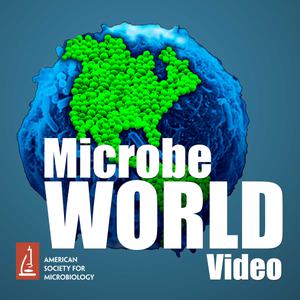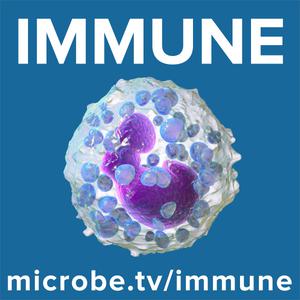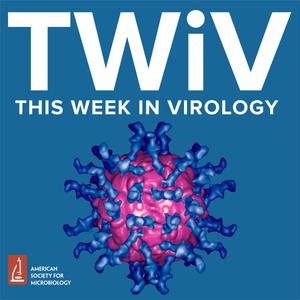
MicrobeWorld Video
American Society for Microbiology
- 12 minutes 34 secondsCRISPR from a Bacteriophage Perspective
The most common analogy for CRISPR systems is that of molecular scissors. Joe Bondy-Denomy offers an alternative analogy from the bacteriophage perspective, all based on scientific data.
👍 Subscribe to ASM's YouTube channel
🔬 Learn more about the American Society for Microbiology at asm.org
✅ Become a member today at asmscience.org/join
📱 Join us on social:
25 February 2020, 8:00 pm - 7 minutes 46 secondsMicroplastics in the Water and their Interaction with Microbes
We may not see microplastics, but they are all around us. These microplastics play a role in shaping the microbial environment, and this talk will explain how.
👍 Subscribe to ASM's YouTube channel at https://goo.gl/mOVHlK
🔬 Learn more about the American Society for Microbiology at http://www.asm.org
✅ Become a member today at http://www.asmscience.org/join
29 January 2020, 10:25 pm - 30 minutes 55 secondsNew Engaging Approaches for Science Communication
Science communication experts discuss creative ways (like variations of escape-the-room, the Up-Goer Five Challenge, or edible learning aids) to get people to interact with science.
Jennifer Gardy, Kathryn (KT) Elliott, and Dave Westenberg discuss the inspiration for their creative approaches and tips for other who want to improve their scicomm skills.
👍 Subscribe to ASM's YouTube channel at https://goo.gl/mOVHlK
🔬 Learn more about the American Society for Microbiology at http://www.asm.org
✅ Become a member today at http://www.asmscience.org/join
📱 Interact with us on social at:
Facebook Show your support and get updates on the latest microbial offerings and news from the ASM.
http://www.facebook.com/asmfan
6 August 2018, 6:31 pm - 30 minutes 55 secondsDisease Detective - Anne Schuchat - Principal Deputy Director of CDC
CDC Principal Deputy Director Anne Schuchat has extensive experience in global health and science advocacy. Jennifer Gardy interviews Schuchat about emerging disease threats and what advice for early-career scientists Schuchat can offer.
Schuchat talks about translating disease detective work into policies that decrease infection rates, citing the successes in decreasing group B Streptococcus infections, developing group A meningococcal vaccines, and halting the recent West African Ebola outbreak. Schuchat talks about her road from an Emerging Infectious Disease fellow to her role in preparing for emerging disease as Deputy Director, and her vision for a future of interdisciplinary collaboration for the greater benefit of global public health.
👍 Subscribe to ASM's YouTube channel at https://goo.gl/mOVHlK
14 July 2018, 12:08 am - 1 hour 13 minutesMWV 112 - Astronaut Kate Rubins on TWiV, live from Microbe 2017
From ASM Microbe 2017 at New Orleans, Vincent and Rich meet up with Kate Rubins to talk about becoming an astronaut, space travel, and doing science in space.
Hosts: Vincent Racaniello and Rich Condit
Guest: Kate Rubins
Thumbnail Photo by Chris Condayan
Intro music is by Ronald Jenkees
Send your virology questions and comments to [email protected]
21 June 2017, 6:35 pm - 1 hour 16 minutesMWV 111 - TWiM live at Microbe 2017: Rigor, lotteries, and moonshots
At Microbe 2017 in New Orleans, the TWiM team speaks with Arturo Casadevall about his thoughts on the pathogenic potential of a microbe, rigorous science, funding by lottery, and moonshot science.
Hosts: Vincent Racaniello, Michael Schmidt, Elio Schaechter and Michele Swanson.
Guest: Arturo Casadevall
Subscribe to TWiM (free) on iPhone, Android, RSS, or by email. You can also listen on your mobile device with the Microbeworld app.
Become a patron of TWiM.
Links for this episode
-
Pathogenic potential of a microbe (mSphere)
-
Rigorous science (mBio)
-
Funding by lottery (mBio)
- Moonshot science (mBio)
Send your microbiology questions and comments (email or recorded audio) to [email protected]
20 June 2017, 10:14 pm -
- 6 minutes 35 secondsMWV 110 - How to Create Agar Art Using Living Microbes
Step inside the creative process with Agar Art 2015 winners Maria Peñil Cobo, Mixed Media Artist, and Mehmet Berkmen, PhD, Staff Scientist at New England Biolabs. During their multi-year collaboration, Maria and Memo have created astonishing works of art using living microbes. Find out how they meld science and art with this behind-the-scenes how-to video guide. Inspired? Submit your own agar art to ASM’s Agar Art 2017 contest through April 27, 2017 - http://www.asm.org/index.php/public-outreach/agar-art
Prizes include up to $200 in Amazon gift cards and the chance for your art to be featured in the Agar Art Gallery at ASM Microbe 2017 (http://www.asm.org/index.php/asm-microbe-2017), June 1-5, 2017 in New Orleans, LA. Submissions must be high-resolution photos of an organism(s) growing on agar. Submitting artists must be ASM members ( http://asmscience.org/content/membership/all) or work with an official ASM Agar Art partner organization to create the submitted piece. Questions? Contact [email protected].
1 March 2017, 2:35 pm - 1 hour 15 secondsMWV 109 - The Never-ending Vaccine Race
Veteran medical journalist Meredith Wadman discuses her book The Vaccine Race. It tells the timely, epic, and controversial story of the development of the first widely-used normal human cell line and, through it, important viral vaccines, including the vaccine for rubella (German measles). Far from being an instrument of history, vaccine development in the modern era is targeting new (and reemerging) infectious diseases, including Ebola, Zika, Influenza and Respiratory Syncytial Virus (RSV). Dr. April Killikelly, a scientist at NIH's Vaccine Research Center, discusses the latest tools and technologies used to design tomorrow’s vaccines.
About the Speakers
Meredith K. Wadman, B.M., B.Ch., M.Sc. Staff Writer, Science
Meredith Wadman is a neuroscience reporter at Science magazine in Washington, D.C. Before joining Science, Wadman was an editorial fellow at New America, a Washington, D.C. think tank. Prior to that, she was a reporter covering the medical research community for Nature for 17 years. She has also written on biotech and on biomedical policy issues for The New York Times, The Washington Post, The Wall Street Journal, Time and Fortune magazine. Wadman is a graduate of Stanford University and completed medical school at Oxford, where she was a Rhodes Scholar. She also earned a master's degree at the graduate school of journalism at Columbia University.
April Killikelly, PhD Postdoctoral Fellow, Vaccine Research Center, National Institute of Allergy and Infectious Disease, National Institutes of Health
Dr. Killikelly is a Postdoctoral fellow working on a vaccine for Respiratory Syncytial Virus (RSV) with Dr. Barney Graham at the Vaccine Research Center (NIAID/VRC). April is also a special volunteer with the Outreach and Education office of the Smithsonian’s National Museum of Natural History. She is passionate about using outreach and education to place science in the broader context of culture and as drivers for societal change.
27 February 2017, 3:08 pm - 5 minutes 48 secondsMWV 108 - My First Microscope
In late July, 2016 ASM ventured below the equator, joining public and private sector partners at the Asia-Pacific Economic Cooperation’s (APEC) Women in Science (WiSci) STEAM Camp in Chaclacayo, Peru. ASM Young Ambassador to Uruguay, Dr. Paola Scavone, and ASM Program Coordinator Laetitia Diatezua led four microbiology workshops in Spanish at the camp, teaching 100 girls how to build a cell-phone microscope, plate bacteria, extract DNA, and view bacteria using their handmade microscopes. This year’s camp was a joint collaboration between private sector entities, and the White House’s Let Girls Learn Initiative, US Department of State, UN Foundation’s Girl Up, and APEC’s Women in the Economy focus.
17 November 2016, 5:39 pm - 1 hour 8 minutesMWV 107 - The Necrobiome: Microbial Life After Death
What happens to us after we die? A decomposing corpse becomes its own mini-ecosystem, hosting insects, scavengers and multitudes of microbes. Microbes from the environment, the corpse, as well as the insects and scavengers are blended together and work to recycle tissues back to their constituents. Dr. Jennifer DeBruyn discusses the fascinating process of human decomposition, and how scientists are using that information to inform forensic science, livestock mortality management and fossilization.
20 October 2016, 6:16 pm - 1 hour 4 minutesMWV 106 - This Week in Virology - Boston Quammens
Four years after filming 'Threading the NEIDL', Vincent and Alan return to the National Emerging Infectious Diseases Laboratory BSL4 facility at Boston University where they speak with science writer David Quammen.
Links for this episode- David Quammen's website
- Spillover by David Quammen
- Threading the NEIDL (TWiV 200)
- The NEIDL at Boston University
This episode is brought to you by CuriosityStream, a subscription streaming service that offers over 1,400 documentaries and nonfiction series from the world's best filmmakers. Get unlimited access starting at just $2.99 a month, and for our audience, the first two months are completely free if you sign up at curiositystream.com/microbe and use the promo code MICROBE.
This episode is also brought to you by Drobo, a family of safe, expandable, yet simple to use storage arrays. Drobos are designed to protect your important data forever. Visit www.drobo.com to learn more. Listeners can save $100 on a Drobo system at drobostore.com by using the discount code Microbe100.
Send your virology questions and comments to [email protected]
25 September 2016, 12:00 pm - More Episodes? Get the App
Your feedback is valuable to us. Should you encounter any bugs, glitches, lack of functionality or other problems, please email us on [email protected] or join Moon.FM Telegram Group where you can talk directly to the dev team who are happy to answer any queries.
 Immune
Immune
 This Week in Virology
This Week in Virology